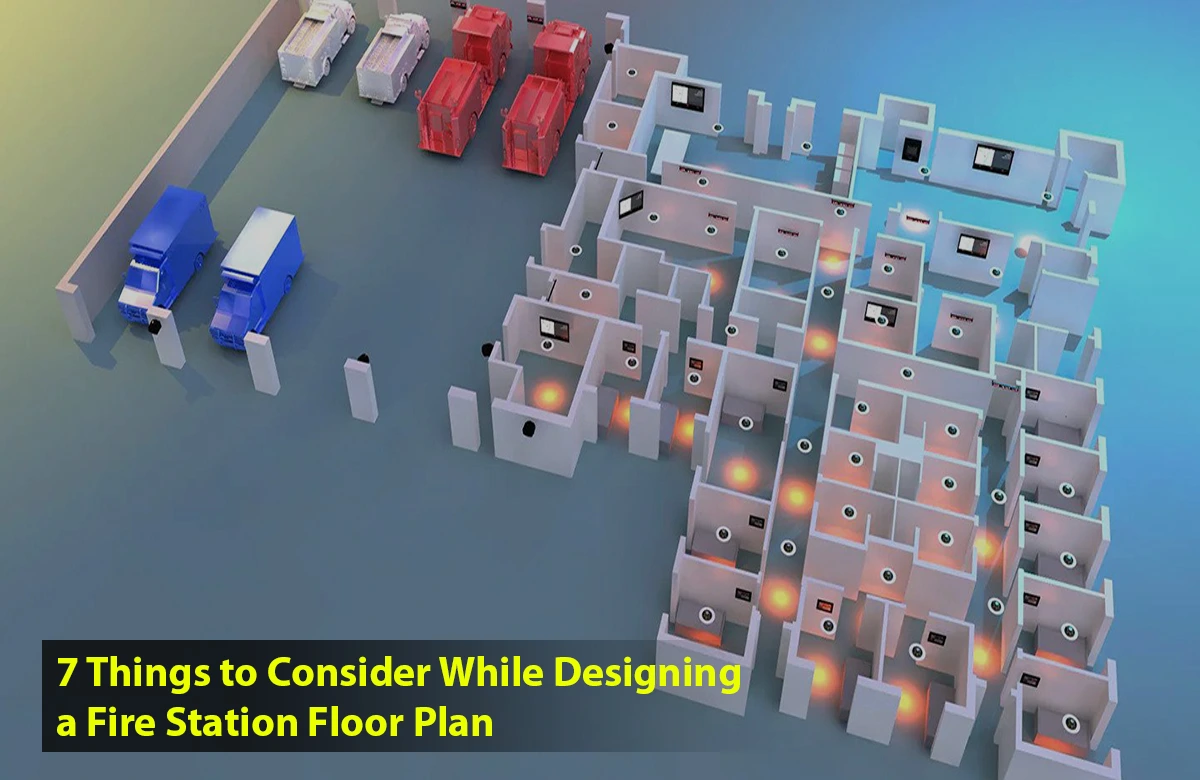Integral Parts of Fire Station Floor Plans: Shouldn’t be Messed With
- February 25, 2023
Designing fire station floor plans isn’t a cakewalk. The list of factors one needs to think about before finalizing a plan is endless. There is the size, storage space, security, offices, drainage, training space, maintenance space, etc.
Among all the factors that require attention, here are some of the most important things that no one shouldn’t take lightly while designing fire station floor plans.
Check out these factors and save your floor plan from being an absolute disaster.
7 Things to Consider While Designing a Fire Station Floor Plan

As mentioned before, though there are hundreds of factors, these 7 are one of the most crucial ones. Take a look!
Determining the Location
When designing a fire station, the most important factor to pay attention to is the location. Setting up a station miles away from the city ain’t going to help much.
An ideal fire station location would be a central area from where firefighters can go in all directions faster. Plus, the station should be in a place that has access to most of the major roads and highways.
Space Required
The second thing to consider, when designing a fire station floor plan, is determining the space that’ll be needed for the station. How much space will is needed depends on the following factors –
- Number of vehicles that’ll be housed
- Size of the vehicles
- Type of vehicles
- The number of people that’ll be living
- Number of rooms for the firefighters
- Equipment storage rooms
- Training areas
- Apparatus bay
- Offices
- Storage room
- Maintenance space
- Decontamination room
Apart from these, there are some other factors as well, such as space for recreational activities, guest rooms, etc.
Apparatus Bays
The place where firefighting and other emergency response vehicles are stored is called the Apparatus Bay. One needs to be very careful when designing the apparatus bay because it plays a role in how quickly the fighters will be able to respond.
If the apparatus bays aren’t designed properly, it might be hard and time-consuming to take the vehicles out of the station. As a result, more time will be required to reach the spot when people need help.
Apparatus bays should be large enough to easily house all department vehicles whether it’s a giant fire truck or a small ambulance.
They should have enough space on the sides, front, and back of the vehicles when parked so that firefighters can effortlessly get in or out of the vehicles and do maintenance.
Plus, these bays need to be well-ventilated as well so that exhaust fumes coming from the vehicle can go away. Otherwise, harmful gasses will start to build up which might make that area uncomfortable for the firefighters.
Moreover, apparatus bays should have proper drainage which will make cleaning vehicles easy.
Dorm Rooms
Usually, firefighters spend long hours in the station waiting for a call. And when they’re at their job the amount of mental and physical stress they go through is unimaginable.
Therefore, to make sure they remain fit mentally and physically, their living quarters need to be designed properly. The sleeping quarters of the firefighters should be away from the apparatus or vehicle bay.
Otherwise, noise coming from vehicles and other fighters and the exhaust fumes might hamper sleep. Plus, the rooms should be spacious and have proper beds, bathrooms, lounges, dining areas, kitchens, etc.
Training Area
This is an integral part of a firefighter’s job, therefore, a fire station should have adequate space where the fighters can do all the drills and exercises. So, the training space needs to be big enough so that every group can do their things comfortably.
The minimum size for training space should be 20 feet wide and 30 feet long, and the ceiling height should be around 14 feet at least, says National Fire Protection Association (NFPA).
It’s best to find a quiet location for training space so that fighters can fully focus on the training.
Storage Space
The storage location should be near the fire engine (the vehicle that’s used to tackle fire). So that loading and unloading stuff will be easy and that’ll increase the response time too.
Another factor that needs to be considered when planning for the storage space is the size of the items that’ll be stored. That should give an idea about the required space.
Decon Process
The floor needs to be planned in a way that, when firefighters come back to the station after responding to emergencies, they first go through the decontamination room.
This is to make sure that hazardous contaminants that come with the body, cloth, and equipment don’t spread to other areas.
2 Major Pitfalls to Avoid When Designing a Fire Station Floor Plan
Here we’ve listed two of the most common pitfalls that people make while designing fire station floor plans. Go through and see if you’re making these mistakes or not.
Not considering Future expansion
With time, the number of fire engines, firefighters, equipment, etc. will increase. Therefore, more space will be required. Hence, fire stations should be designed in such a way that they can be expanded in the future.
Slow Response
A fire station needs to be designed in a way that will allow firefighters to respond very quickly. Designers should try their level best to come up with a plan that will decrease the response time.
For example, setting the fire apparatus location very close to the road will allow firefighters to respond first.
Learn more: Drafting Table Assembly Instructions for Beginners.
Frequently Asked Questions on Fire Station Floor Plans
Following queries and their answers will come in handy for you to make a draft plan.
How long does it take to build a fire station?
There is no definitive answer to this question as the time required to build a fire station depends on many factors such as the size of the station, floor plans, working speed, etc.
How long is a fire engine?
Typical fire engines are 30 to 36 feet long, around 8 feet wide, and 9 to 12 feet tall. However, there are exceptions.
How many rooms should small fire station floor plans include?
The number of rooms required in a small fire station depends on the number of firefighters, fire engines, equipment, etc.
Conclusion
When designing fire station floor plans, it’s also mandatory to have a bunch of senior firefighters on the committee. Due to their experience, they’ll be able to make better suggestions which will help in planning the floor better.
With that said, ending the guide here, we hope it helps.
